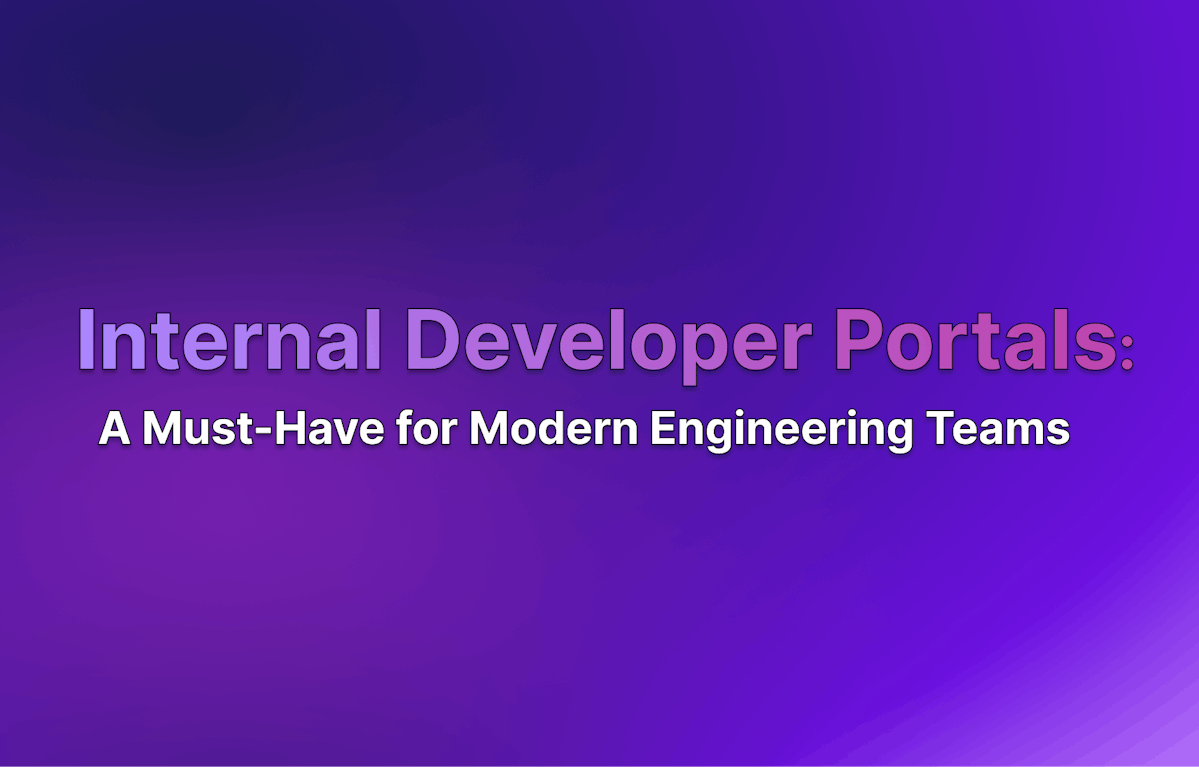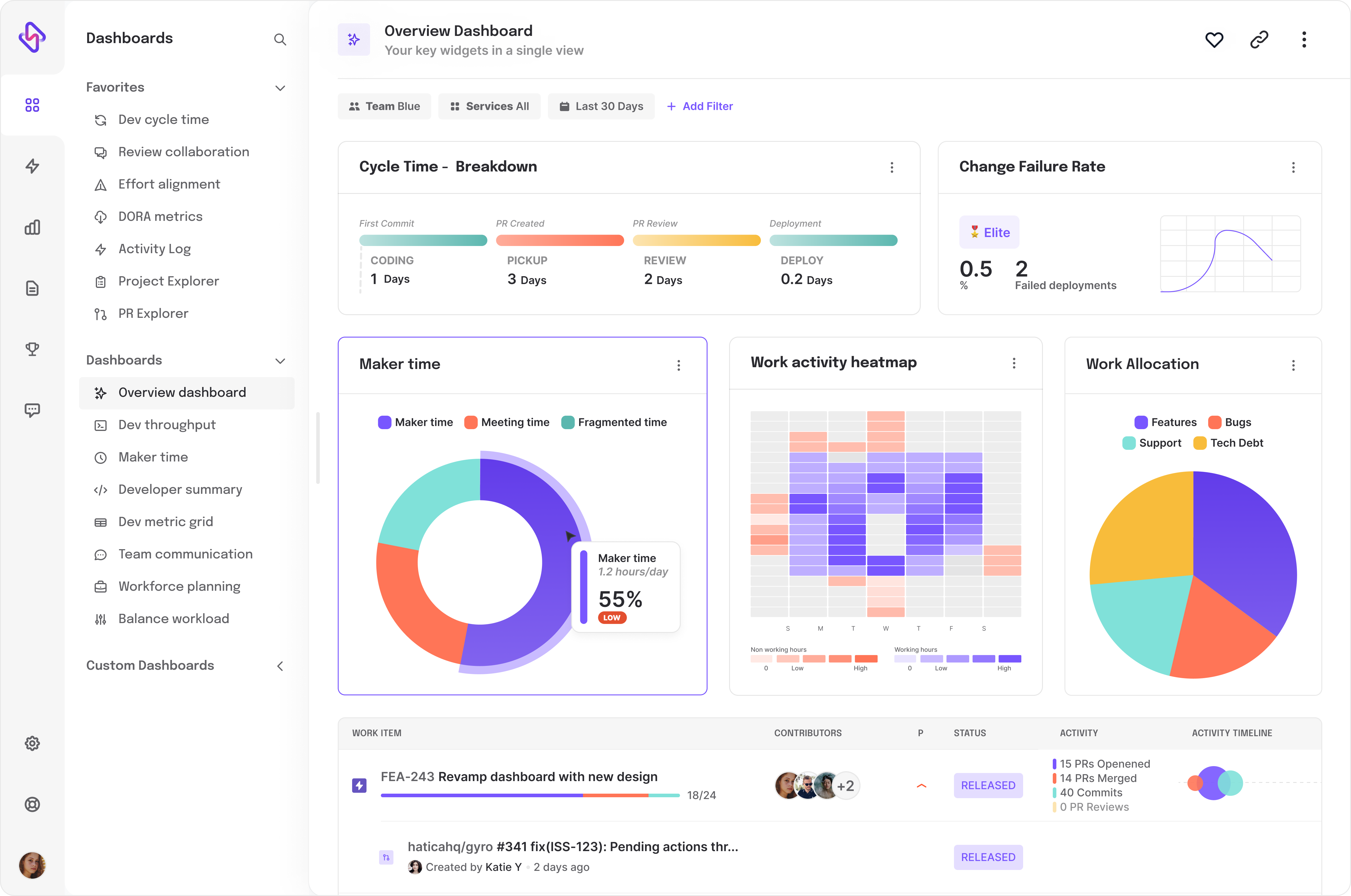However, the reality for many software developers today is far from this ideal. Developers often find themselves caught up in outer loop tasks, such as integration, security compliance, and scaling deployments.
This mismatch doesn’t just sap developer morale—it creates inefficiencies that ripple across the entire engineering organization. An IDP minimizes this cognitive tax by acting as a structured memory for your organization. It integrates scattered systems into a cohesive whole, allowing engineers to focus on high-leverage tasks instead of navigating the noise.
How Does an Internal Developer Portal Actually Work?
An Internal Developer Portal (IDP) acts as a structured memory, pulling together all your tools, services, and data into a single, cohesive interface.
Picture this: Without an IDP, you might spend 30 minutes bouncing between CI/CD logs, Kubernetes dashboards, and Slack threads just to troubleshoot a deployment issue. With an IDP? That same information is distilled into a single view in seconds—one that ties the issue to the exact service, owner, and recent changes.
It’s not just about saving time; it’s about avoiding the wrong turns. Every unnecessary switch fractures focus, delays decisions, and increases the risk of incomplete or bad calls. An IDP eliminates these detours, surfacing the right data, tools, and actions when and where they’re needed.
Who Uses Internal Developer Portals (IDPs)?
Internal Developer Portals (IDPs) serve a wide range of stakeholders in engineering teams. Here’s how different roles leverage them:
Developers
- Find ownership, dependencies, and changes instantly.
- Spin up new services with best-practice templates.
- Focus on building instead of navigating workflows.
Engineering Leaders
- Gain visibility into team performance and service health.
- Prioritize resources with real-time insights.
- Ensure alignment with organizational standards.
SREs
- Enforce reliability standards seamlessly.
- Manage on-call rotations with actionable data.
- Shift focus from firefighting to proactive improvements.
- Enable self-service infrastructure with guardrails.
- Maintain consistency across environments effortlessly.
Staff Engineers
- Use IDPs to drive technical consistency across teams.
- Identify and address architectural bottlenecks quickly.
- Guide teams in adhering to engineering best practices.
Security Teams
- Enforce security baselines, like vulnerability scanning and code coverage.
- Proactively catch risks by setting thresholds for unresolved issues.
- Ensure software is secure and production-ready from day one.
What are the Core Components of an Internal Developer Portal?
An Internal Developer Portal (IDP) pulls together all the tools, processes, and standards that developers need into one seamless user experience. But it’s not just about convenience—it’s about cutting through the noise and helping developers do what they do best: build.
A great IDP is built around four core components:
- A software catalogue to map and organize software components
- A system to score and track software health and standards
- Self-service tools to give developers the power to move fast, safely
- Automations to keep the momentum going
Let’s break down what these mean in real life.
1. Software Catalogue: The Engineering Map
Every engineering team has its version of a service catalog—maybe it’s a spreadsheet, a wiki, or just institutional memory (read: someone on Slack at 2 a.m.). A software catalogue replaces all that with a single, living source of truth for everything your team builds and manages.
It’s not just about listing services—it’s about context. Who owns this service? What’s it connected to? Is it healthy? For example, if a service breaks, you don’t need to Slack five people to figure out who owns it or scroll through GitHub for clues. The catalog has your back.
Why It Matters:
- Clear Ownership: No more “who’s responsible for this?” moments.
- Faster Fixes: See recent commits, dependencies, and status at a glance.
- Unified View: Track everything from microservices to Kubernetes clusters in one place.
The real magic happens when the catalog integrates with your stack. It pulls in data from monitoring tools, CI/CD pipelines, and documentation to give you a complete picture of your software ecosystem. Suddenly, it’s not just a list—it’s a map you can actually use.
2. Scorecards: The Built-In Gut Check
Here’s where things get interesting. A good IDP doesn’t just show you what’s in your stack—it tells you how it’s doing. Scoring tools evaluate your software for things like security, maturity, and cost efficiency.
For example, imagine a scorecard that flags out-of-date dependencies or missing vulnerability monitoring. Or an operational maturity scorecard that tracks things like test coverage, README presence, and on-call readiness. These aren’t just checkboxes—they’re insights that drive better decisions.
Types of Scorecards:
- Security: Identify risks before they become headlines.
- Health: Track test coverage, uptime, and incident frequency.
- Cost Optimization: Spot over-provisioned resources and save on cloud costs.
System scorecards aren’t about policing—they’re about giving engineering teams the data they need to improve. For example, seeing that your rollback rate is higher than expected might prompt a closer look at your deployment practices. And fixing that? That’s where the real wins happen.
3. Automations: Let the Busywork Handle Itself
Let’s face it—engineers didn’t sign up to babysit deployments, chase down dependencies, or manually update environments. That’s where automations come in, quietly taking care of the repetitive, time-consuming tasks so your team can focus on building and problem-solving.
Think of automations in your Internal Developer Platform (IDP) as your team’s behind-the-scenes superpower. They ensure processes run smoothly, reliably, and without constant hand-holding.
Key Features:
- Build and Deploy Code: Automatically handle the grunt work of building, testing, and deploying code changes whenever someone pushes a commit.
- Fix Issues Before They Become Fires: Automate alerts, ticket creation, and on-call notifications when something goes wrong, so your team can jump on it immediately.
- Keep Dependencies Fresh: Spot outdated libraries or packages and update them automatically, keeping your codebase secure and current.
- Spin Up Environments Instantly: Need a staging or test environment? Automations can create and tear them down as needed—no waiting, no fuss.
- Scale Resources Automatically: Traffic spikes? Automations can scale servers or pods up and down to handle the load without missing a beat.
4. Self-Service Actions: Give the Power Back
Ask any developer, and they’ll tell you: that waiting for approvals or hand-holding through processes is the fastest way to kill momentum. That’s why self-service is the crown jewel of an IDP. It lets developers handle routine tasks—like spinning up a new service or deploying code—without waiting on someone else.
Key Features:
- Scaffolding: Generate new projects with pre-configured templates that follow best practices.
- Deployment Actions: Push code to production or configure environments in just a few clicks.
Self-service actions don’t mean “wild west.” The best IDPs come with built-in guardrails. Templates ensure new services are secure and production-ready from day one. Deployment actions align with your organization’s standards. Developers get freedom without the risk of chaos.
What’s the Difference Between an Internal Developer Portal and an External Developer Portal?
External Developer Portals came first, designed to help external developers work with a company’s APIs. These portals typically include:
- Documentation and resources to support API integration.
- Forums for troubleshooting and sharing knowledge.
- Spaces to explore and test API products with robust support.
Think of them as a developer-friendly front door for external API users, offering everything needed to understand and use APIs effectively.
Internal Developer Portals, on the other hand, focus on supporting internal engineering teams. They provide:
- Cataloging tools to manage services, dependencies, and ownership.
- Scoring systems to assess service health and production readiness.
- Templates and workflows that improve consistency and efficiency.
While their purpose is different, internal portals can also manage APIs for internal use, much like external portals manage APIs for external developers. In essence, IDPs bring the same structure and support internally that external portals offer to the outside world—just tailored to the needs of your own teams.
Why Are Internal Developer Portals Gaining Traction Now?
The growing interest in Internal Developer Portals (IDPs) isn’t just a passing trend—it’s a response to the challenges that modern engineering teams face as they scale. With fragmented tools, increasing operational complexity, and the pressure to deliver faster than ever, teams are realizing that the traditional ways of working simply don’t cut it anymore.
But why now? Let’s unpack the key drivers behind this shift and explore why IDPs have become a critical enabler for today’s engineering organizations.
1. The Complexity Problem is Growing
The modern software stack isn’t what it used to be. Teams are juggling microservices, Kubernetes clusters, CI/CD pipelines, monitoring tools, and infrastructure automation—just to name a few. While these tools have brought immense power and flexibility, they’ve also introduced fragmentation and cognitive overload for developers.
2. Engineering Efficiency is Non-Negotiable
In a world where time-to-market can make or break a product, engineering efficiency is no longer a nice-to-have—it’s a competitive advantage.
3. The Growing Focus on Developer Experience
It’s no secret that retaining top engineering talent is a challenge. Developers want more than just competitive salaries—they want tools and processes that make their lives easier and allow them to deliver their best work.
4. A Shift Towards Standardization and Best Practices
As development teams scale, maintaining consistency becomes a monumental challenge. From naming conventions to security standards, it’s all too easy for things to spiral into chaos without a centralized system to enforce best practices.
With built-in scorecards and guardrails, an IDP helps organizations standardize their processes.
Platform engineering teams are redefining how organizations support developers. IDPs are the foundation of modern platforms, enabling teams to scale efficiently while maintaining quality.
Therefore, the question isn’t “Do you need an IDP?” It’s “How soon can you start reaping the benefits?”
The Future of Internal Developer Portals (IDPs)
We’re likely to see standalone IDP tools evolve with smarter automation and predictive capabilities. Imagine your IDP not just flagging inefficiencies but also suggesting exactly how to cut costs without hurting performance, or guiding you step-by-step through a framework migration with minimal risk.
In the next few years, IDPs will be at the very core of how engineers build.
At the same time, IDP-as-a-feature will grow as more DevOps and observability platforms integrate these tools. This shift will make IDPs more accessible and reinforce their role as the central system of record for engineering teams.




